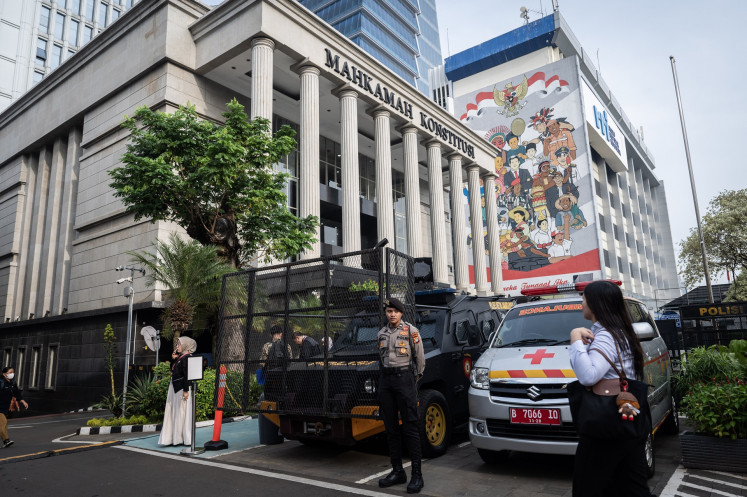Reviving ‘I La Galigo’ Creation Myth
Beginnings: I La Galigo will return to the stage in Jakarta’s Ciputra Artpreneur theater from July 3-7
Change text size
Gift Premium Articles
to Anyone

B
eginnings: I La Galigo will return to the stage in Jakarta’s Ciputra Artpreneur theater from July 3-7. It was premiered in Singapore 15 years ago. (JP/Wendra Ajistyatama)
Longer than the Mahabharata and comparable to Homer’s Odyssey, I La Galigo recounts the creation and destruction of the Middle World, the realm of white-blooded descendants of the gods.
I La Galigo may sound like the title of an Italian opera, but it is also the title of an ancient creation myth from South Sulawesi that American playwright Robert Wilson has translated into an avant-garde piece of performance art on stage, with movement, light and space as major elements.
And when the curtains open on its vernissage night on July 3 at Ciputra Artpreneur Theater in South Jakarta, where it will be staged until July 7, we will sense a different energy, a different rhythm (as Wilson once relayed) — something you have to experience. In fact, this ancient cosmic myth reveals a sense of the divine and the human experience at the same time.
Watching a procession of figures carrying goods from an ancient world slowly pass from right to left on a stage of changing hues is like entering a world of wondrous colors, where speech is replaced by stylized gestures and the passing of time indicated by the changing of a colored horizon; grey-green lined with light blue merge into various hues of blue, purplish grey, blood red and vibrant green.
As the procession proceeds in an almost never-ending rhythm, flying figures evoke the notion of natural movements, like that of the wind or thunder, breaking the rhythm of slowness and the silence of a world that seems to lie far behind us — but is in fact, very close.
The visuals are inspired by the epic creation myth Sureq Galigo, which has been reinterpreted to represent the Bugis world at the dawn of its history. Longer than the Mahabharata and comparable to Homer’s Odyssey, it recounts the creation and destruction of the Middle World, the realm of white-blooded descendants of the gods.
The late Puang Matoa Saidi, former head of the Bugis society’s bissu (transgender shamans), said in an interview before the first edition was staged 15 years ago that every shade had a meaning, every place its significance.
“Yellow, for instance, is the color of the Luwuq kingdom and of royalty; purple is for the aristocracy and red is for commoners. Blue stands for clarity, beauty and the environment, in which life can prosper.

Not many people realize that this poetical creation myth emerged from the realms of the 14th century and remained in the public knowledge of today through the efforts of one woman.
Dozens of manuscripts in the archaic Bugis language are scattered in the residences of families in the region. They are believed to have been written by more than one author.
The person to bring together the various manuscripts was a woman by the name of Retna Kencana Colliq Pujie Arung Pancana Toa Matinroi ri Tucai — Arung Pancana Toa for short. Born in 1812, she was the queen of Pancana, a tiny kingdom within the kingdom of Tanete, where her daughter, We Tenriolle, was queen.
Like many women of her standing, Arung Pancana Toa was highly literate, wrote poetry and was well informed about the epic that many in her circle and the Bugis people until today considered sacred.
Arung Pancana Toa was an exile of the Dutch in Makassar, South Sulawesi, when Dutch missionary BF Mattes, a researcher of Bugis script and literature, asked her help to gather and copy the old manuscripts on lontara (a Brahmic script used by the Bugis) that lay scattered across the region and put them in order.
The Dutch had exiled her to Makassar because of her fierce opposition against the colonial regime. Put on a paltry monthly allocation and some rice, she urgently needed some additional income to make ends meet, so she eagerly accepted.
During 25 of her life, Arung Pancana Toa helped Mattes copy the Galigo manuscripts and put them in chronological order, editing them into 12 large manuscripts that were then placed in the safekeeping of the Leiden University Library in the Netherlands.
As this was only one-third of the 6,000 folio pages of which the Galigo cycle consists, she made an abstract of the whole cycle, and it is thus that the red thread running through the hundreds of episodes is known.

Many Galigo scholars have emerged since then; Christian Pelras, Sirtjo Koolhof, Roger Tol, Ian Caldwell, Gilbert Hamonic, Mattulada, Muh. Salim, Fachruddin Ambo Enre and others are among the well-known ones.
Against such a male formation of scholars stands Nurhayati Rahman, the only known female Galigo scholar with an academic degree, currently a professor of philology at the Hasanuddin University’s School of Cultural Science in Makassar.
Nurhayati obtained her doctorate cum laude with her dissertation on Galigo. As many people come to her to learn more about Galigo, she has become known as Siti Galigo, conducting numerous presentations in local as well as international forums.
She was also the coeditor of the book translations of Galigo I, II, and III, in which she edited the Galigo verses in a way that they aligned with literary demands.
Roger Tol of the Royal Netherlands Institute of Southeast Asian and Caribbean Studies (KITLV) at Leiden University was recently in Jakarta and he revealed that these three books, which were published by Obor Jakarta, are just a small part of the entire cycle, and more funding is needed to further the literary translation of the remaining documents.
Meanwhile, Nurhayati, who is now 62 years old, revealed that she has started to bring in younger scholars who should succeed her.
While Arung Pancana Toa engaged in physical opposition against colonial rulers and spent 20 years of her life saving the heritage of I La Galigo, she has yet to be nominated as a national heroine.
A monument in her honor was erected in Tanete (now Barru), South Sulawesi, but the photograph available is blurred. With no photographs of her profile available, her legacy is nevertheless tangible, waiting for official recognition.
The photograph from the Tropen Museum that has for some time been marked as Arung Pancana Toa, is, in fact, a picture of her daughter, We Tenriolle, the queen of Tanete (1855-1910). Yet Tol confirmed that it is a good representation of how she might have looked like.

‘Galigo’ On Stage
It may not be too surprising it was women who came up with the initiative to bring Galigo to the stage.
Rhoda Grauer, an American filmmaker with vast experience in theater production, was seeking material for a film on bissu, the transgender shamans who once held an esteemed position at Bugis courts, when she was introduced to the Galigo cycle to find out more clues about their existence.
“I couldn’t believe there could be such an amazing story — so beautifully written so long ago, longer than the world’s great epics text — that was still virtually unknown to the world outside of South Sulawesi,” she explained.
When she learned there were fewer than 100 people alive who still read and understood the manuscripts, she thought something had to be done.
She shared her thoughts with Restu Imansari Kusumaningrum, an artist and active promoter of arts and culture who is also the director of the Bali Purnati Center for the Arts, which she founded with six friends and focuses on exposing little-known cultures to the outside world.
They agreed on Wilson to come in for a contemporary presentation of the mythical epic.
Restu, who knew Wilson, revealed that the playwright had often asked her for an authentic Indonesian drama for the stage.
“I love the Galigo cycle, it speaks of a rich culture. Reading the Galigo is like entering a world of visual arts with images of Salvador Dali’s surrealistic world springing up in my mind,” Restu said.
Through Wilson, the project was introduced to Elisabetta di Mambro, one of the partners of Change Performing Arts, an independent production company based in Milan, Italy, that had produced various works by Wilson.
Again, by the initiative and strong will of a woman, Rina Ciputra, who witnessed Galigo in Bali last October, this wondrous myth will be accessible to those who have not yet experienced it.
“I wish for everybody to know and experience our cultural heritage,” she said. (ste)









